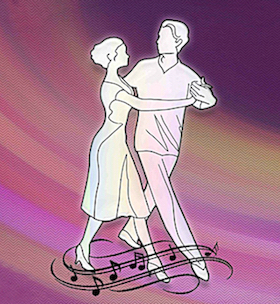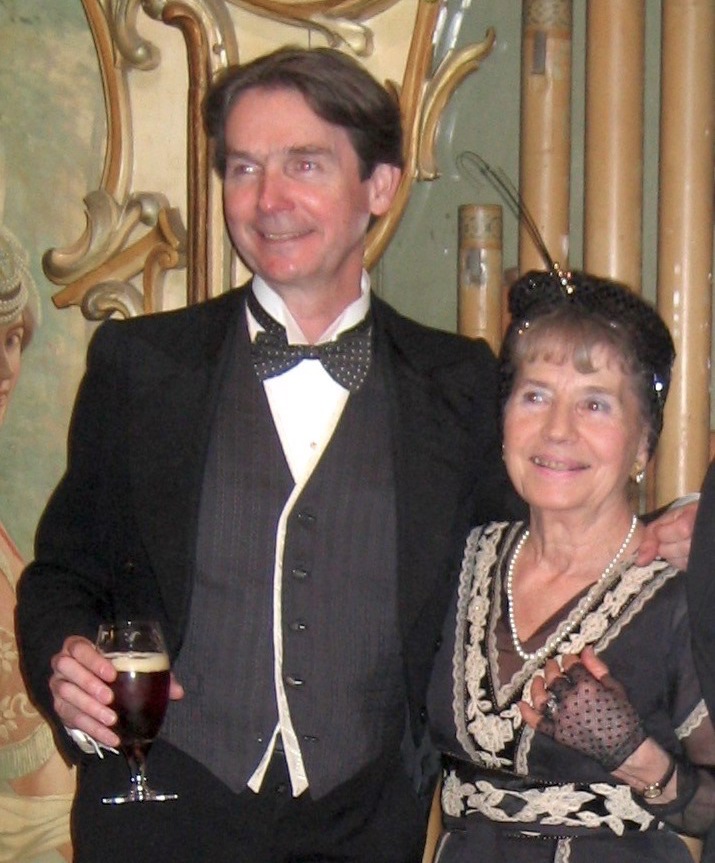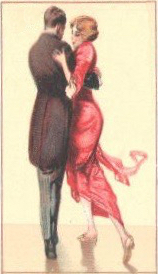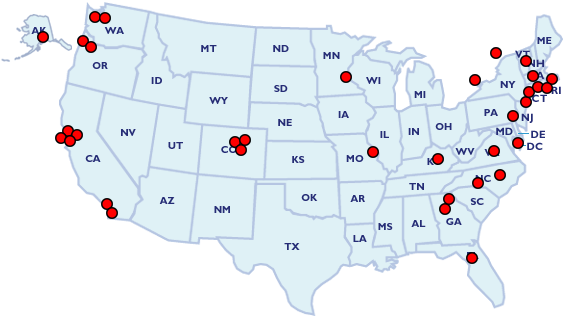
Cross-Step Waltz
Richard Powers

How does the cross-step facilitate creativity?
In most waltzes, dancers face each other squarely and dance directly toward their partners on the downbeat, or back away from them, whether rotating or not.

In cross-step waltz, the dancers essentially travel side-by-side at the musical downbeat, count 1, because their rear foot crosses through toward the direction of travel, placing them briefly in promenade position. This parallel traveling allows an infinite array of variations that easily travel past and around one's partner.
• Both dancers can travel laterally together, as in promenades or grapevines.
• The Follow role can pass in front of the Lead role or turn independently, as in swing.
• Similarly the Lead can pass in front of the Follow or turn independently.
• Or the dancers can face each other and rotate as in traditional waltz.
And these variations can be done right at the count-1 downbeat of the musical phrase, without a delayed maneuver to "break out of the frame." This enhances spontaneity and musicality.
The flexible frame of cross-step waltz also allows dancers to travel laterally in the opposite direction (counter-promenade position) on the secondary cross-step, count 4, doubling the directional possibilities in every turn of the waltz. Every Basic Step offers an easy opportunity to travel "out the front door" (in the direction of the primary cross-step) or "out the back door" (toward the secondary cross-step).
Because of this multidirectional flexibility, cross-step waltz combines…Exiting a figure
• the rotation of waltz
• the lateral travel of tango and foxtrot/quickstep (dancers travel together)
• underarm turns and figures of swing and salsa (dancers travel independently)
• the pivots of polka and hambo
An important part of innovating a variation is getting out of it, returning back to the basic step. Returning to the frame of both box and rotary waltzes is a bit tricky, since someone must step into their partner at the same instant that their partner is also stepping back on the opposite foot. If either the placement or timing is a bit off, someone can get stepped on. Therefore exiting a figure is especially difficult if you're trying out new figures on-the-fly. But in cross-step waltz you return to your partner's side, without intertwined footwork, which is significantly easier and safer.

Field research
|
 |

|
Cross-steps in general appeared in the first three decades of the 20th century. In 1914, the "Cross Walk Boston" waltz created by Frank H. Norman foreshadowed the cross-step waltz, but most of the early crossed-step variations were in duple 4/4 time, in the One Step, Tango, and Foxtrot. In particular, the March 1920 issue of the Dancing Times of London reported that in the Foxtrot, "The crossing of the feet is popular and effective." A three-step version of the foxtrot was popular immediately after World War I and through the 1920s. It was a repeating pattern of three steps danced quick-quick-slow, called Straight Jazz and Jazz-Roll in London. In 1919, "Monsieur Pierre" described the Jazz Valse thusly: "A new form of valsing, derived from the Jazz, is rapidly gaining popularity. It is danced especially to slow and accentuated music. The steps are the same as the Straight Jazz and Jazz-Roll, with a step to every beat." This means dancing the three foxtrot steps evenly in slow waltz time. The English dance master Geoffrey D'Egville suggested the same thing in 1919. Dancing the Jazz Valse using crossed foxtrot steps results in cross-step waltz in the manner that has been revived today. |

Frame (Waltz Position): The Lead's R arm and Follow's L arm are somewhat raised but not stiff, with the top of his R arm lightly in contact with the bottom of her L arm. His R palm rests gently on her L shoulder blade, giving a bit more space between partners than other waltz forms. He should be careful not to poke the fingertips of his R hand into her back. She braces back with her R arm, but both dancers hold each other with soft comfortable hands.
This is a flexible frame dance. Both upper bodies are slightly aimed toward the held hands on count 1, the Primary Cross-Step, and slightly aimed toward the rear elbows on count 4, the Secondary Cross-Step.
|
• Reverse Turning Basic • Reverse Waterfall • The Square • Zig-Zag Evasive Maneuver • Lead's "A" Stance in Follow's Solo • Sweeps • Counter-Crossing • Direction Change from Follow's Solo • Follow's Solo in Waterfall • The same into Swingout • Lead's Back Ochos • Traveling Back Ochos • Follow's Swingout • Traveling Swingout • Hoo-Wah! • Traveling Swingout Tuck-Turn • Traveling Swingout Tuck-Free Spin • Traveling Swingout Tuck Into Shadow Position • Traveling Swingout Dishrag Tuck-Turn • Side-Passes • Open Two-Handed Tossacross • Side Sways • Swan Dive • Leads Back Ochos into a Flip Pivot • Alternating Flip Pivots • 2-Hand Bounced Ochos • Bounced Ochos in Closed Waltz Position • Cloud Hands Zig Zag • Cloud Hands Lead's Back Ochos • Waltz Walk • The Eddy • Rueda • Splits • Waltz Walk Underarm Turn • Waltz Walk Free Spin • Double Outside Underarm Turn • Follow's Initiated Double Underarm Turn • Underarm Turn Free Spin • Lindy Outside Turn • Lindy Outside Turn Triple Free Spin • Repeated Lead's Underarm Turn • Surprise Outside Turn at end of He-Goes-She-Goes • Lead's Underarm Turn, Pivaloop, Long Grapevine • Pomander Turn • He-Goes-Rollaway • Hovercraft • Single Pivot • Tripled Single Pivots • Pivot Underarm Turn • Pivot with Follow's Free Spin • Pivot Rollaway • Chained Rollaways • Doubled Pivots • Easygoing Extended Pivots • Texas Tommy Pivot • Whipped Turning Basic • Lazy Cast-Away • Gypsy • Jedi Waltzing (Innovation) • Grapevine • Grapevine Rueda • Long Grapevine Rueda • Long Grapevine, Tuck-Double Outside Turn • Long Grapevine, Outside Turn, Free Spin • Long Grapevine, Parallel Free Spin, Double Outside Turn • Long Grapevine, Inside And Outside Turns • Long Grapevine, Inside Turn, Free Spin • Follow's Backing Ocho (Zig-Zags) • Exit from Follow's Backing Ochos • Grapevine Exit from Follow's Backing Ochos • Grapevine Underarm (Outside) Turn • Grapevine Underarm Turn Sandwich • Grapevine Free Spin • Open 2-Hand Grapevine Free Spin • Closed Grapevine Rollaway • Grapevine Underarm Turn into Counter-Crossing |
• Inside Turn, Grapevine • Inside Free Spin, Grapevine • Tandem Inside Free Spin, Grapevine • Inside Rollaway, Grapevine • Turns And Grapevine Sandwich • Meandering Grapevine With Inside And Outside Turns • Chained Inside And Outside Turns • Open 2-Hand Chained Inside And Outside Turns • Magic Wand • Single-Hand Chained Inside And Outside Turns • Pancake (Chained Free Spins) • Inside Turn To Cradle Walk • Cradle Promenade Changing Sides • Double Unwind Exit From Cradle • Deney Terrio Unwind Exit From Cradle • Tornado Quintuple Unwrap From Cradle • Exit From Wrap To Grapevine Free Spin • Inside Turn Cradle Lunge • Inside Double Turn To Outside Double Turn And Free Spin • Inside Double Turn To Outside Triple Turn • Open Grapevine • Open Grapevine Rollaway • Open Grapevine Underarm Turn • Open Grapevine Free Spin • Open Grapevine Combinations • Inside and Outside Grapevine Combinations • Open 2-Hand Tossacrosses To Grapevine Free Spin • Inside Free Spin • Pivot to Inside Turn • Follow's Solo To Grapevine Inside Turn • Waterfall Grapevine Inside Turn • Waterfall Grapevine Tuck-Turn • Matador • Pivaloop • He-Goes-She-Goes Entrance to Pivaloop • Dishrag Pivaloop • Free Spin Exit from Pivaloop • Double Pivaloop • Pivaloop Extra Underarm Turn • Lead's Wrap into Pivaloop • Waterfall Grapevine Inside Turn into Pivaloop • Reverse Pivaloop • Cross-Body Inside Turn • Cross-Body Lead into Chained Inside and Outside Turns • Cross-Body Inside Turn Into Pivaloop Free Spin • Orbit Inside Turn Into Reverse Pivaloop • Walk-Around Drape • Cross-Body Ochos • Tsunami • Underarm Tsunami • Shadow Figures (Sweetheart Variations) • Shadow Walk • Follow's Side Slips • Shadow Wheel • Reverse Shadow Wheel • Follow's Underarm Turn • Follow's Multiple Underarm Turns • Lead's Side Slip • Mixmaster • Shadow Sweeps • He-Goes-She-Goes Entrance into Shadow • Quicker Entrance into Shadow • Grapevine Underarm Turn Entrance into Shadow • Traveling Swingout Entrance into Shadow • Free Spin into R/R Hand Underarm Turn into Shadow • Foot-Fudge into Shadow • Illusion Turn (Shadow Flip) • Shadow Windmill (Chained Follow's Underarm Turns in Shadow) • Windmill • Parallel Windmill • Shadow Zig-Zag |
• Basic Exit from Shadow • Face-Loop Exit from Shadow • Sombrero Exit from Shadow • From Shadow Position, W On R Side, Transition To Lead's Hammerlock • Tandem Turns • Traveling Tandem Turns • Transition To Skater's at his Left Side • Transition To Skater's With Extra Inside Turn • Side Pass To Skater's At His Right Side • Inside Turn Transition From Skater's At His Left Side To Skater's at his Right Side • Flip Turn • Chained Flip Turns • Crossed-Hand Waltz • Right Forearm Grasp • Runs Forward and Backing • Runs Forward and Backing with Free Spin • Open 2 Hand Fallback • Two-Hand Mixmaster • One-Hand Pivaloop Mixmaster • Crossed-Hand Salsa Mixmaster • Around the World • Around the World Free Spin • Loop-de-Loops • Traveling Loop-de-Loops • Sombrero • The Wrap • Waist Slide into Wrap • Walk-Around Wrap • Exit from Wrap to Shadow Position • Exit from Wrap to Grapevine Free Spin • Pivot To Salsa Parallel Breaks • Pivot To Straight Salsa Breaks • Cross-Swivels (Swivel Walk) • Tango hesitation • Molinete • Corkscrew Molinete • Left Turn Pivots • Left Turn Pivots into Grapevine • Forward Cross-Lunge, Side Step Recovery • Tango Hesitating Dip • Closing Tango Dip • Hesitating Dip Into Pivots Into Follow's Double Underarm Turn • Closing Underarm Turn • Closing Underarm Turn with Genuflections • Concluding Inside Turn Cradle Dip • Lateral Dip (Cradle Dip) • Traveling Roll-Off-The-Arm • Free Spin Dip • Traveling Free Spin • Valentino Dip • Sombrero Dip • Improvise on the Spot (Make Up Stuff) • Transition to Cross-Step from Box Step Waltz • Transition Back to Box Step Waltz • Cross-Through Traveling Box Step Waltz • Transition from Rotary Waltz • Transition to Rotary Waltz • Cross-Step Redowa (to faster music) • Tripling (Cutting In) • Cross-Step Troika • Slow Cross-Step Foxtrot • Fast Cross-Step Foxtrot (Cross-Step One-Step) • Role Reversal • Use Orbits to get into Role Reversal • Stealing the Lead (Messing with the Lead) • Stealing the Lead with Free Spins • Surprise Ochos • Stealing the Lead with Surprise Side-Pass • Stop-And-Go to phase-shift musical downbeat • CrossChaCha • Stop-And-Go Transition from Rotary Waltz • Stop-And-Go Transition to Rotary Waltz |